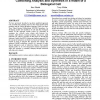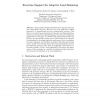162 search results - page 13 / 33 » Simulating Structural Change in Adaptive Organizations |
NOMS
2010
IEEE
13 years 5 months ago
2010
IEEE
—We present WiMFlow, a dynamic and self-organized flow monitoring framework in Wireless Mesh Networks. The protocol allows for an autonomic organization of the probes, with the ...
IPTPS
2005
Springer
14 years 28 days ago
2005
Springer
Application-level multicast on structured overlays often suffer several drawbacks: 1) The regularity of the architecture makes it difficult to adapt to topology changes; 2) the u...
HICSS
2003
IEEE
14 years 21 days ago
2003
IEEE
Strategic management literature suggests that especially in young and dynamic industries Virtual Corporations are more likely to emerge, as this type of organization is flexible e...
SAC
2004
ACM
14 years 25 days ago
2004
ACM
for ideas, and then abstract away from these ideas to produce algorithmic processes that can create problem solutions in a bottom-up manner. We have previously described a top-dow...
IPPS
2000
IEEE
13 years 11 months ago
2000
IEEE
Abstract. Many parallel scienti c applications have dynamic and irregular computational structure. However, most such applications exhibit persistence of computational load and com...


